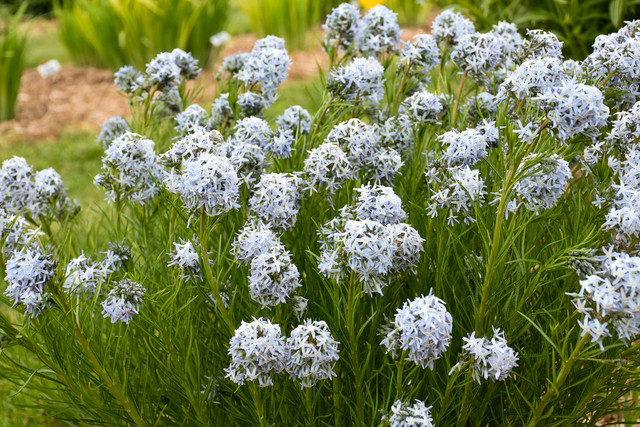
Amsonia
Uses:
- Borders
- Specimen or Focal Point
- Container Thriller
Features:
- Attracts Pollinators
- Cut Flowers
- Native to North America
Sunlight:
- Partial Sun to Full Sun
- At Least 5 Hours of Direct Sunlight
Growing Zones:
- 4-9
- What is My Zone?
Amsonia, also known as blue star, are prized for their clusters of delicate, star-shaped blue flowers in spring and their vibrant golden foliage in fall. These hardy plants thrive in sunny to partially shaded locations with well-drained soil, making them ideal for borders, cottage gardens, or mixed perennial beds.
About Amsonia

Blue Star, Arkansas Blue Star
North America
Bushes
Deciduous
4 to 9
Pale Blue, Lavender-blue
Late Spring to Early Summer
Upright, Clump-forming
Butterflies, Pollinators
Drought, Deer, Clay Soil
Deer, Rabbits
How To Use Amsonia In The Garden
Amsonia, commonly known as blue star, is a perennial plant admired for its soft blue, star-shaped flowers that bloom in late spring. The plant forms neat, shrub-like clumps reaching up to 2-3 feet in height and width, with narrow, lance-shaped leaves that turn a brilliant golden yellow in the fall. This seasonal color change adds multi-seasonal interest to gardens.
Amsonia is effective in mixed borders, providing a soft texture that complements larger-leaved plants like peonies and hostas. The plant's ability to attract pollinators, such as butterflies and bees, enhances the ecological value of the garden. Additionally, Amsonia is deer-resistant and drought-tolerant once established, making it a practical choice for low-maintenance landscapes.
Amsonia Care
Amsonia, also known as Bluestar, should be planted in spring or autumn in locations receiving full sun to partial shade. While it tolerates various soil types, it thrives in loamy, moist, well-draining soil with a pH close to neutral. Maintain watering during establishment, providing at least one inch per week. Fertilization needs are minimal; you can apply a balanced fertilizer in nutrient-poor soils to support growth during the blooming season.
Pruning is not mandatory but can enhance plant vigor. Cutting back the foliage to about 8 inches after blooming encourages denser growth and prevents self-seeding. In colder regions, leave the spent foliage in place and apply mulch around the root zone. Amsonia adapts well to large outdoor containers; use a pot with at least a 3-gallon capacity filled with moist, well-draining soil, and place it in a spot with ample sunlight.
Learn More About Amsonia Care

Amsonia Companion Plants
Choose companions that thrive in full or dappled sun, evenly moist yet well‑drained soil, and USDA zones 3‑9, which suit amsonia. Little bluestem mirrors the prairie aesthetic and shares drought‑tolerant roots, while Russian sage threads silvery stems and late‑summer lavender spikes through amsonia’s starry bloom period. Catmint keeps pollinators busy with a long wave of nectar‑rich flowers, and oakleaf hydrangea adds bold summer cones followed by burgundy foliage, finishing the season when amsonia’s leaves turn gold.








